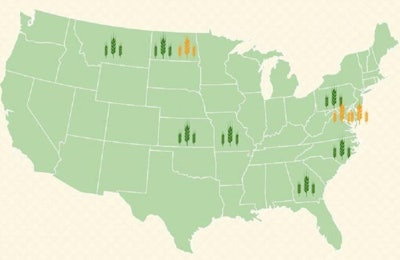
Share this Image On Your Site
The U.S. wheat and barley harvests are complete. According to Neogen, reports of DON in wheat and barley came in from several states.
DON is produced by fusarium graminareum mold. This is the same mold that produces fusarium head blight (FHB), and the two are commonly associated in wheat. However, in some cases, DON can still be present even if FHB is not spotted.
DON is a member of the trichothecene group of compounds which also includes T-2 toxin, DAS, nivalenol and perhaps as many as 100 others. DON can be found in free form as produced by the fungus and also in masked forms, which are metabolites produced by plants invaded by the fungi.
There are three modes of action of DON and the other trichothecenes:
- DON is pharmacologically active and this causes behavioral changes such as loss of appetite, loss of muscle coordination and lethargy.
- DON inhibits protein synthesis and this causes necrosis of epithelial cells. The tissue most affected in the manner is the lining of the intestinal tract. This can cause bleeding into the intestinal lumen, increased frequency of ulcers and damage to the absorptive surfaces causing reduced nutrient uptake.
- DON is immunosuppressive. This can cause lingering health problems in poultry, which becomes non-responsive to medication and vaccination.
Pigs are highly sensitive to DON. Two well-known effects of DON in pigs are anorexia and feed refusal. About 54-89 percent of DON can cross the intestinal epithelium in pigs and are detected in the blood. Intestinal cells are the first cells to be exposed to DON and at much higher concentrations than other tissues. It should be kept in mind that the effect on the intestine is only one part of the consequences in animals fed DON-contaminated feed.
Because DON tends to be higher on lightweight, damaged kernels or fines, wheat growers should take these precautions:
- Be proactive by increasing fan speed on combines to 1,375 to 1,475 rpm and increasing shutter openings to 3.5 inches.
- When storing grain, it should be screened as it goes into storage and screened again when it is removed from storage.
- Screening should not be used for livestock feed.
- If the wheat grain contains DON, the straw from the crop will contain DON also, so care must be used if the straw is destined for feeding or bedding.


















